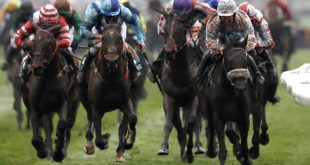bettingexpert.com Racing editor Stephen Harris digests the latest Ladbrokes woes and identifies five implications for the industry.
The headlines in the press said it all last week as the beleaguered bookmaker suffered yet another dire set of results, particularly when compared with William Hill, Paddy Power and Bet365. But what do these shocking figures mean for the industry as a whole and, more pertinently, the future of horse racing?
 1 – Racing, away from the major festivals, no longer carries the confidence as a product for bookmakers
1 – Racing, away from the major festivals, no longer carries the confidence as a product for bookmakers
In his latest statement Ladbrokes CEO Richard Glynn issued a stark warning to the sport..
“Horse racing as a product continues to decline. Concerns continue to mount within the industry around the costs related to horse racing and the provision of racing content. While the racing industry continues to pursue strategies to increase its revenue from betting, the value it delivers continues to decline. This new reality needs to be understood.”
So basically, one of the main cheerleaders for more and more cheap, low grade racing now calls for racing to sort itself out and become a more attractive product (having done exactly as it was asked by the paymasters over the last decade).
Ladbrokes in the last few years have significantly ducked out of competing price-wise in the early markets, betting to a much larger theoretical percentage than their rivals, and presumably assuming this will not affect their “inelastic” punters in the shops who are unconcerned whether they are getting 6-4 (when Hills are offering 15-8). This kind of logic does not work on the internet however, where price is everything and more savvy punters are driven not by brand loyalty but by purely seeking out value (the top price).
Some facts (via the excellent Alun@poker_hack on twitter):
“William Hill’s online profits were 27 times bigger than Ladbrokes’ in H1 2014. Twenty. Seven.”
“Another nice comparison from Ladbrokes H1 results. World Cup online up 40% on 2010. Awesome. Oh hang on, it was up 211% at Hills?”
“When Richard Glynn took over as Ladbrokes CEO he focused on improving digital performance. 2010 H1 digital profit £29.1m . 2014 H1: £3m.”
In fairness, there are some mitigating circumstances in 2014, with Ladbrokes making a major play to be strong and competitive at the bigger meetings i.e Royal Ascot and the Epsom Derby, offering top prices and laying them in size to all in the shops. However, the run of favourites and well backed winners meant this change of tactic was rewarded with losses rather than increased profits (though does explain the increased revenues).
2 – Small field, low grade, uncompetitive midweek racing is a major turn off
The best races for turnover predictably came during Cheltenham, Aintree and Epsom but interesting were not the massive, big field lottery handicaps that the larger firms are constantly demanding. Quality seems to be preferred over quantity, with Group 1 and Championship NH races capturing the imagination of all punters. Who knew?
See the top 10 races for turnover so far in 2014 here.
The midweek “programme” (from Sunday to Thursday) has now been left to largely rot on the vine, with the quality and field sizes at some meetings now verging on farcical (combined with double digit non-runners every day at times during the flat season). Punters have voted with their feet, including many pro’s such as John Basquill (who find getting on a near impossible task at the lower end of the spectrum).
 3 – Higher margins/lower cost FOBTs and games are now the core product for bookmakers
3 – Higher margins/lower cost FOBTs and games are now the core product for bookmakers
The truth is that racing is being bypassed by both bookmakers and punters seeking out a less complex, instant thrill in their betting. Football (especially in-play) is now racing ahead and the money printing FOBTs/online games now much preferred by both backer and layer.
For bookmakers this is a no-brainer. No huge media rights to pay, or expensive levy payments, no skilled traders to pay, just empty the machines and sling up 700 markets into big percentages on the live football.
Go ahead firms such as Bet365 have led the way in this regard, recently posting huge profits and increased revenues by focussing hard on cornering the market in these high margin arenas. Actively courting inelastic punters has proved an astute move on their part, while more established firms like Ladbrokes struggle to make an impact (even “The Ladbrokes Life” adverts have attracted attention for the wrong reasons).
4 – Has cut-throat pricing, BOG and allowing marketing teams a free hand destroyed profitability?
Racing has become a loss leader for the firms, using it as a means of directing punters onto more profitable areas on their websites and shops. During the big meetings, everyone was cutting their own throats to attract the bigger players with money back offers, enhanced place terms and regular price boosts making the bottom line margin minimal. There cannot have been many times in their history that a firm the size of Ladbrokes has actually lost overall at Royal Ascot and Epsom and it isn’t purely down to a freak set of results.
Furthermore, while the PR teams go into overdrive for the big festivals and weekend racing they do nothing to promote racing midweek. Walk past any betting shop, the windows are full of adverts for the latest machine or the enhanced price for Wayne Rooney to score first. Multiple bets such as Yankees are left in the corner, ignored and untouched by an unaware younger audience. Unless racing and the bookmakers make a concerted effort to market an attractive product properly, the future looks especially bleak.
 5 – Racing must tear itself away from relying on arcade owners as their core source of funding
5 – Racing must tear itself away from relying on arcade owners as their core source of funding
In the longer term racing must unattach itself from the levy and become self reliant and self funding. It must stand on its own two feet, charging for picture rights and attracting race-sponsorship on merit. The racecourses need to stage meetings that attract crowds and are viable in themselves. It can be done. Look at Chester, Ascot, Goodwood etc etc.
If off-course bookmakers want racing to just be shop fodder (see the BAGS model in greyhound racing for details), then let them buy and run the tracks themselves and pay for it accordingly (Betfred buying the former Great Leighs track will be interesting in the coming months).
All these issues are complex and finding a solution that suits all parties is clearly a difficult struggle, but what is clear is that the current model (based entirely on the profits of those firms who are no longer interested in racing), is totally unsustainable and heading for the rocks.
This article appeared in its original form on www.bettingexpert.com
_________________________










